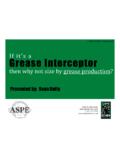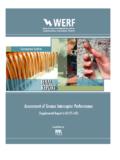Transcription of Best Management Practices (BMPS for Non-Residential Direct ...
1 Best Management Practices (BMPS) for Non-Residential Direct and Indirect Dischargers of grease to the Public Sewer System From Title 15 of the Rules of the City of New York 19-11 Best Management Practices (BMPs) for Non-Residential Direct and Indirect Dischargers of grease to the Public Sewer System. (a) grease Interceptors shall be installed in waste lines which may receive grease from Non-Residential Direct and indirect dischargers, including, but not limited to, those leading from pot wash sinks, woks, soup or stock kettles, food scrap sinks, scullery sinks, meat and/or poultry and/or fish preparation sinks, floor drains, automatic dishwashers, scraper sinks or other similar plumbing fixtures in all restaurants, kitchens, cafeterias, clubs, butcher shops, slaughterhouses, fish markets, supermarket food processing areas, delicatessens or other Non-Residential establishments where grease may be introduced into the drainage system.
2 Sizing of grease interceptors shall comply with the criteria specified in this section, including applicable Tables I and/or II. (b) All prefabricated grease interceptors shall be approved by the New York City Board of Standards & Appeals prior to July 10, 1991, approved by the New York City Department of Buildings Materials and Equipment Acceptance Division prior to July 1, 2008, or shall conform to PDI G101, ASME or ASME and shall be installed in accordance with the manufacturer s instructions. (c) The method for determining the minimum size/capacity of a grease interceptor is provided in Tables I and II below: Note: Aggregate volume is the maximum volume ( length times width times height to the overflow if rectangular) in cubic inches of all fixtures, vessels and receptacles that may flow simultaneously through the interceptor .
3 * Subject to the sizing requirements specified in sections 19-11(i) through (p). Aggregate volume in cubic inches of all fixtures listed in this grease interceptor retaining capacity for: pot sinks, food prep. Sinks, scullery sinks and floor drains which are used for washdown purposes volume in cubic inches of all fixtures, vessels and receptacles listed in this grease interceptor retaining capacity for: scraper sinks, woks, automatic dishwashers and any fixture receiving discharge from soup and stock kettles.*up to 2,4628 (lb)up to 1,2318 (lb)2,463 to 4,31214 (lb)1,232 to 2,15614 (lb)4,313 to 6,16020 (lb)2,157 to 3,08020 (lb)6,161 to 9,24030 (lb)3,081 to 4,62030 (lb)9,241 to 12,32040 (lb)4,621 to 6,16040 (lb)12,321 to 15,40050 (lb)6,161 to 7,70050 (lb)15,401 to 21,56070 (lb)7,701 to 10,78070 (lb)21,561 to 30,800100 (lb)10,781 to 15,400100 (lb)30,801 to 46,200150 (lb)15,401 to 23,100150 (lb)46,201 to 61,600200 (lb)23,101 to 30,800200 (lb)61,601 to 92,400300 (lb)30,801 to 46,200300 (lb)92,401 to 123,000400 (lb)46,201 to 61,600400 (lb)
4 Table ITable II If a premises contains fixtures listed in Table I and fixtures, vessels and/or receptacles listed in Table II, all of which are tributary to the same grease interceptor , then the method for determining the minimum grease interceptor retaining capacity in pounds shall be to separately calculate the retaining capacities for the fixtures in Table I and the fixtures, vessels and/or receptacles in Table II. These retaining capacities shall then be added together to obtain the total minimum grease interceptor retaining capacity required for such premises. If the aggregate volumes listed in Tables I and II are exceeded, then a New York State Licensed Professional Engineer or a New York State Registered Architect shall extrapolate the appropriate grease interceptor sizing requirements. (d) Vented flow control fittings shall be installed to insure that the flow capacity of the grease interceptor as specified by the manufacturer is not exceeded.
5 Flow-control valves and/or fittings that are manually adjustable may not be used to limit flow to an interceptor . (e) grease interceptors must have a retention capacity in pounds of at least twice the numerical flow-through rate in gallons-per-minute. (f) grease interceptors shall remove an average of 90 percent or more of the grease or other extractable matter in the wastewater. (g) The temperature of water entering a grease interceptor shall not exceed 180 F. (h) All grease interceptors must be readily accessible for inspection by duly authorized employees of the Department. (i) grease interceptors for scraper sinks shall be sized in accordance with Table II, except that the minimum retaining capacity shall be at least 30 pounds. When determining the aggregate volume of all fixtures, vessels and receptacles specified in Table II that may flow simultaneously through an interceptor , a minimum of 3,465 cubic inches per scraper sink shall be used.
6 (j) Dischargers from automatic dishwashers must be tributary to a grease interceptor . Whether connected separately or in conjunction with other fixtures, the total volume in gallons of each automatic dishwasher shall be converted to cubic inches and added to the aggregate volume of Table II. (k) Discharges from high-temperature sanitizer cycles of automatic dishwashers or from dedicated sanitization compartments of sinks need not be tributary to a grease interceptor . (l) Floor drains which may receive grease must be tributary to a grease interceptor . The size of such grease interceptor shall be determined as follows: (1) For floor drains where grease maybe discharged during washdowns, Table I shall be used, and an additional 1,540 cubic inches per floor drain shall be added to the aggregate volume. (2) grease interceptors for floor drains which receive discharges directly from fixtures, receptacles and/or vessels shall be sized in accordance with the grease interceptor sizing requirements for the fixtures, vessels and/or receptacles tributary to it.
7 (3) For floor drains having a diameter larger than 3 inches or for trench and/or trough drains, a New York State Licensed Professional Engineer or a New York State Registered Architect shall extrapolate the appropriate sizing requirements of the tributary grease interceptor based on (1) and/or (2) above. (m) For soup and/or stock kettles, the calculation of aggregate volume to be used in Table II shall be made based upon the total volume of all soup and stock kettles tributary to the grease interceptor even if the discharges from these vessels are made to a floor drain or similar fixture. (n) Where woks, either alone or in conjunction with other types of fixtures, are tributary to a grease interceptor , each wok shall be deemed to contribute 1,617 cubic inches to the aggregate volume of Table II. (o) Discharges from the cleaning of kitchen hoods which may extract grease from cooking operations must be made to receptacles or floor drains that are tributary to a grease interceptor .
8 The sizing of the tributary grease interceptor must account for such discharges using standard engineering practice. For kitchen hoods with automatic rinse cycles, the tributary grease interceptor must be sized to account for the peak flow from the automatic rinse cycle as specified by the manufacturer. (p) Interceptors smaller than those described in Tables I and II may be used, but only if connected in parallel to another interceptor (s), and the aggregate capacity of such interceptors must either equal or exceed the interceptor capacity required by Tables I an/or II. For parallel connections, vented flow control fixtures must be installed on each interceptor . (q) grease interceptors shall be properly installed, maintained and operated to insure that the requirements of this section and other applicable sections of the regulations are met.
9 This shall include routine cleaning and grease removal from the interceptor as needed to insure the proper operation of the interceptors. (r) New York State Licensed Professional Engineers and New York State Registered Architects may petition the Commissioner in writing for acceptance of an alternative pretreatment device, technology, equipment or procedures varying from, but equivalent to, those listed in this section. Such a petition must contain detailed documentation and calculations substantiating their equivalency. In no event shall any alternative pretreatment device, technology, equipment or procedures be less stringent than the requirements of this section. (s) Notwithstanding any other provision of this section, (1) existing grease interceptors shall conform to the specific requirements of this section no later than one year after the effective date of this section, and (2) grease interceptors installed after the effective date of this section pursuant to an application filed before such effective date shall conform to the specific requirements of this section no later than 90 days after such effective date.
10 (t) Notwithstanding anything contained in section 19-11 the Commissioner in his discretion may require any grease interceptor to be installed at any time and to have a retention capacity equal to those listed in Tables I and/or II. 4/2014











